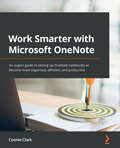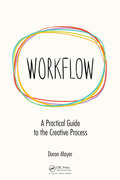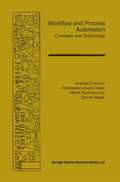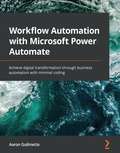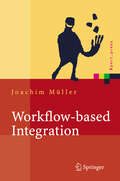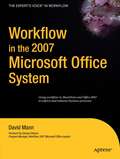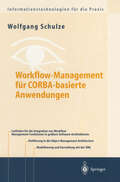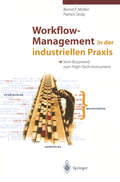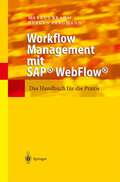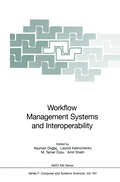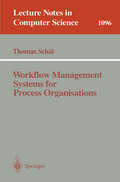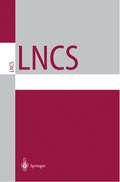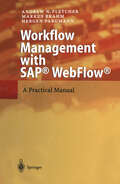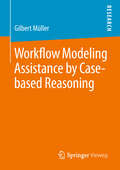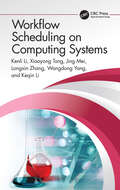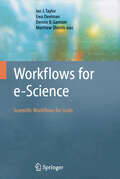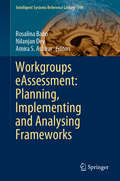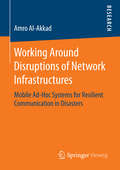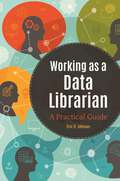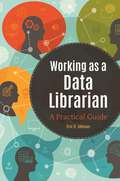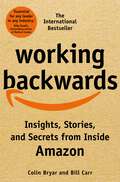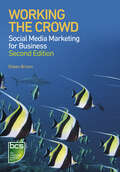- Table View
- List View
Work Smarter with Microsoft OneNote: An expert guide to setting up OneNote notebooks to become more organized, efficient, and productive
by Connie ClarkOrganize work and home life using notes from your phone or computer to supercharge your productivity with this OneNote manualKey FeaturesLearn how to store notes that include images, audio, videos, links, files, emails, and web clippingsUnleash the magic of tags to make notes stand out and become more searchableDiscover the power of shared notebooks with your team or family to ensure everyone is in the loopBook DescriptionDo you want to take your information and note organization to a new level? This book will show you how to use Microsoft's organizational app, OneNote, to store endless amounts of information in a productive and organized way, including solutions for creating your notes and then sharing them easily with your team or department.You'll be guided through everything you need to set up a notebook and customize it to suit you or your team. The book will show you how to navigate through OneNote and search for virtually anything, as well as save time with all the shortcuts. You'll discover that inserting information into your notebooks goes far beyond text, images, and videos, and also includes emails, links to documents, and clippings from the web. But it doesn't stop there. Integration with other Microsoft products is key for making your experience successful, and this book demonstrates how to use OneNote with Microsoft Outlook, OneDrive, SharePoint and Teams. Beyond instructions and essential topics, this book also provides you with the motivation you need to make OneNote a habit as well as real-life examples of notebooks you can use.By the end of this book, you'll be able to use OneNote for everything and from every device. Even if you start a notebook on your laptop and continue it on your phone, you'll find working with the app seamless.What you will learnUnderstand how to create and organize notes in your notebooksDiscover how to turn handwritten notes into typed textExplore how to access your content from anywhere even if offlineUncover ways to collaborate with your team or family and stay in syncUnderstand how to insert your emails, documents, or articles from the webFind out how to integrate with other Microsoft products such as Outlook or TeamsWho this book is forIf you save notes on your phone, wear out more spiral notebooks than you can count, or if you're a Microsoft 365 user and need to keep track of information, then this book is for you. Beginner-level experience with OneNote is required to get the most out of this book.
Workflow: A Practical Guide to the Creative Process
by Doron MeirA pro isn’t just a person who can do it well. It’s a person who can do it well every time, on demand and on deadline; which is why the key to being a professional creative is having a great creative process. Whether it’s writing a book, animating a shot, designing a game level or composing a soundtrack—ultimately, we’re all facing similar challenges. Since we share challenges, we can also share solutions. This book is a practical guide, featuring a universal creative process that can streamline any serious creative work, on any scale. Key Features Universal approach: applies to any process that starts with an idea and ends with a refined product. Profound and light: combines conceptual ideas with practical tips and fun anecdotes. Caricatures and samples: helps visually clarify ideas and processes. Variety of creative fields: draws on examples from writing, animation, game design, 3D modeling, music, sculpting and more Printable summaries: provides visual outlines that can be used as cheat-sheets.
Workflow: A Practical Guide to the Creative Process
by Doron MeirA pro isn’t just a person who can do it well. It’s a person who can do it well every time, on demand and on deadline; which is why the key to being a professional creative is having a great creative process. Whether it’s writing a book, animating a shot, designing a game level or composing a soundtrack—ultimately, we’re all facing similar challenges. Since we share challenges, we can also share solutions. This book is a practical guide, featuring a universal creative process that can streamline any serious creative work, on any scale. Key Features Universal approach: applies to any process that starts with an idea and ends with a refined product. Profound and light: combines conceptual ideas with practical tips and fun anecdotes. Caricatures and samples: helps visually clarify ideas and processes. Variety of creative fields: draws on examples from writing, animation, game design, 3D modeling, music, sculpting and more Printable summaries: provides visual outlines that can be used as cheat-sheets.
Workflow and Process Automation: Concepts and Technology (The Springer International Series in Engineering and Computer Science #432)
by Andrzej Cichocki Helal A. Ansari Marek Rusinkiewicz Darrell WoelkBased on the results of the study carried out in 1996 to investigate the state of the art of workflow and process technology, MCC initiated the Collaboration Management Infrastructure (CMI) research project to develop innovative agent-based process technology that can support the process requirements of dynamically changing organizations and the requirements of nomadic computing. With a research focus on the flow of interaction among people and software agents representing people, the project deliverables will include a scalable, heterogeneous, ubiquitous and nomadic infrastructure for business processes. The resulting technology is being tested in applications that stress an intensive mobile collaboration among people as part of large, evolving business processes. Workflow and Process Automation: Concepts and Technology provides an overview of the problems and issues related to process and workflow technology, and in particular to definition and analysis of processes and workflows, and execution of their instances. The need for a transactional workflow model is discussed and a spectrum of related transaction models is covered in detail. A plethora of influential projects in workflow and process automation is summarized. The projects are drawn from both academia and industry. The monograph also provides a short overview of the most popular workflow management products, and the state of the workflow industry in general. Workflow and Process Automation: Concepts and Technology offers a road map through the shortcomings of existing solutions of process improvement by people with daily first-hand experience, and is suitable as a secondary text for graduate-level courses on workflow and process automation, and as a reference for practitioners in industry.
Workflow Automation with Microsoft Power Automate: Achieve digital transformation through business automation with minimal coding
by Aaron GuilmetteEnhance your organization's productivity by automating repetitive tasks and simplifying business workflows using Microsoft Power Automate (formerly Microsoft Flow) Key Features Create basic and advanced workflows for automating Twitter posts, sending emails, push notifications, and much more Manage user inputs, documents, approvals, and database storage using flow controls Create flows that integrate with services both inside and outside the Microsoft 365 ecosystem Book Description Microsoft Power Automate (formerly Flow) is a workflow automation tool built into Microsoft 365 to help businesses and users to automate repetitive tasks or trigger business processes without user intervention. If you are new to Microsoft Power Automate, this book will give you a comprehensive introduction to help you to get up to speed with automating business processes in no time. Complete with hands-on tutorials, projects, and self-assessment questions, this easy-to-follow guide will show you how to configure automation workflows for business processes between hundreds of Microsoft and third-party applications. Once you understand how to use connectors, triggers, and actions to automate business processes, you'll get to grips with managing user inputs, documents, approvals, and database storage using efficient flow controls. This Power Automate book explains key concepts and takes you through creating your own flows step by step. By the end of the book, you'll have learned how to use Microsoft Power Automate to replace repetitive tasks with business workflow automation technology. What you will learn Get to grips with the building blocks of Power Automate, its services, and core capabilities Explore connectors in Power Automate to automate email workflows Discover how to create a flow for copying files between two cloud services Understand the business process, connectors, and actions for creating approval flows Use flows to save responses submitted to a database through Microsoft Forms Find out how to integrate Power Automate with Microsoft Teams Who this book is for The book is for technologists, system administrators, and Power users with little or no Microsoft Power Automate experience. Familiarity with basic Microsoft 365 services is expected.
Workflow in the 2007 Microsoft Office System
by David MannThis book is written by a developer and architect with 9 years’ experience building Information Worker solutions, including custom workflow engines and third-party workflow products. The author challenges readers to view the Office System and workflow in a new light, walking readers through the process of building a solid, useable workflow solution. Unlike quick references that scratch the surface of new technology, this book benefits the serious Information Worker developer - a growing group in IT - who is interested in learning the inner workings of workflow and Office 12.
Workflow-Management für COBRA-basierte Anwendungen: Systematischer Architekturentwurf eines OMG-konformen Workflow-Management-Dienstes (Informationstechnologien für die Praxis)
by Wolfgang SchulzeWorkflow-Management in der industriellen Praxis: Vom Buzzword zum High-Tech-Instrument
by Bernd F. Müller Patrick StolpWorkflow-Management-Systeme sind ein wesentlicher Faktor zur Bewältigung betrieblicher Herausforderungen. Mit dieser Einführung erhalten Unternehmen einen praxisbezogenen Überblick über die am Markt erhältlichen Workflow-Management-Systeme sowie die effiziente Konzeption und Implementierung eines Workflow-Projektes. Industriell nutzbare Beispiele in SAP Business Workflow erleichtern die praktische Umsetzung.
Workflow Management Systems and Interoperability (NATO ASI Subseries F: #164)
by Asuman Dogac Leonid Kalinichenko Tamer Özsu Amit ShethWorkflow management systems (WFMS) are enjoying increasing popular ity due to their ability to coordinate and streamline complex organizational processes within organizations of all sizes. Organizational processes are de scriptions of an organization's activities engineered to fulfill its mission such as completing a business contract or satisfying a specific customer request. Gaining control of these processes allows an organization to reengineer and improve each process or adapt them to changing requirements. The goal of WFMSs is to manage these organizational processes and coordinate their execution. was demonstrated in the first half The high degree of interest in WFMSs of the 1990s by a significant increase in the number of commercial products (once estimated to about 250) and the estimated market size (in combined $2 billion in 1996. Ensuing maturity product sales and services) of about is demonstrated by consolidations during the last year. Ranging from mere e-mail based calendar tools and flow charting tools to very sophisticated inte grated development environments for distributed enterprise-wide applications and systems to support programming in the large, these products are finding an eager market and opening up important research and development op portunities. In spite of their early success in the market place, however, the current generation of systems can benefit from further research and develop ment, especially for increasingly complex and mission-critical applications.
Workflow Management Systems for Process Organisations (Lecture Notes in Computer Science #1096)
by Thomas SchaelAs the business environment has become more and more turbulent over the past decade, information technology has begun to run into the danger of becoming an impediment rather than a motor of progress. In order to deal with the need for rapid, continuous change, computer science is challenged to develop novel interrelated information and communication technologies, and to align them with the social needs of co-operating user groups, as well as the management requirements of formal organisations. Workflow systems are among the most advertised technologies addressing this trend, but they mean different things to different people. Computer scientists understand workflows as a way to extract control from application programs, thus making them more flexible. Bureaucratic organisations (and most commercial products) perceive them as supporting a linear or branching flow of documents from one workplace to another - the next try after the failure cf office automation. This book takes another perspective, that of the modem customer-driven and groupwork-oriented process organisation. Extending the language-action perspective from the CSCW field, its customer-oriented view of workflows enables novel kinds of business process analysis, and leads to interesting new combinations of information and co-operation technologies. Schal's empirical studies show some of the pitfalls resulting from a naive use of these technologies, and exemplify ways to get around these pitfalls.
Workflow Management Systems for Process Organisations (Lecture Notes in Computer Science #1096)
by Thomas SchaelAll of us have learned a lot during this exercise, and the enormous success of the first edition of this book shows the great international interest for the topic and the results. A French edition appeared last year and met with equal interest. Springer-Verlag has therefore decided to publish a second edition of this book, which is not just a reprint but brings the literature and results to the newest state. This is a rare occurrence in the history of the LNCS series. We congratulate Thomas Schael on this success, and we are sure that reader- scientists and practitioners - will likewise profit from it. Aachen and Milan Giorgio De Michelis, Klaus Henning, Matthias Jarke August 1998 Preface to the Second Edition This book is a bit of a mixture of scientific and management literature. It is based on my research activities in the CSCW community, and also reflects the last ten years of my professional experience in consulting. I have had the opportunity to live in different cultural settings, to work in many companies, and to meet people all over the world, which has helped me to reflect on what I was doing and to focus on the content of this book. This second edition reflects the fast moving field of Computer Supported Cooperative Work (CSCW) and the discussion on Business Process Re-engineering (BPR). It contains the latest developments in the scientific and managerial discussion of the issues developed in the first edition.
Workflow Management with SAP® WebFlow®: A Practical Manual
by Andrew N. Fletcher Markus Brahm Hergen PargmannIt is now possible to gain competitive advantages based on consolidated R/3 system implementations. One of the most important optimisation aspects is a more consistent process integration in order to bring about fast, secure and cost effective business processes. This approach inevitably leads to Workflow Management and for SAP users to SAP® WebFlow®. This book introduces the topic of Workflow Management, gives an overview of the technical possibilities of SAP® WebFlow® and allows the reader to assess SAP workflow project risks and costs/benefits based on real life examples. Check lists and technical hints not only aid the reader in evaluating potential projects but also in the management of real life workflow project engineering.
Workflow Modeling Assistance by Case-based Reasoning
by Gilbert MüllerGilbert Müller introduces the foundations of Business Process Management as well as Case-based Reasoning and presents a novel approach to assist the complex, time-consuming, and error-prone task of workflow modeling. By means of methods from artificial intelligence, in particular from the field of Case-based Reasoning, he shows how workflows can be automatically constructed according to a query specified by the user. Thus, the modeling process can be supported substantially, which addresses a highly relevant problem in many workflow domains.
Workflow Scheduling on Computing Systems
by Kenli Li Keqin Li Xiaoyong Tang Jing Mei Longxin Zhang Wangdong YangThis book will serve as a guide in understanding workflow scheduling techniques on computing systems such as Cluster, Supercomputers, Grid computing, Cloud computing, Edge computing, Fog computing, and the practical realization of such methods. It offers a whole new perspective and holistic approach in understanding computing systems’ workflow scheduling. Expressing and exposing approaches for various process-centric cloud-based applications give a full coverage of most systems’ energy consumption, reliability, resource utilization, cost, and application stochastic computation. By combining theory with application and connecting mathematical concepts and models with their resource management targets, this book will be equally accessible to readers with both Computer Science and Engineering backgrounds.It will be of great interest to students and professionals alike in the field of computing system design, management, and application. This book will also be beneficial to the general audience and technology enthusiasts who want to expand their knowledge on computer structure.
Workflow Scheduling on Computing Systems
by Kenli Li Keqin Li Xiaoyong Tang Jing Mei Longxin Zhang Wangdong YangThis book will serve as a guide in understanding workflow scheduling techniques on computing systems such as Cluster, Supercomputers, Grid computing, Cloud computing, Edge computing, Fog computing, and the practical realization of such methods. It offers a whole new perspective and holistic approach in understanding computing systems’ workflow scheduling. Expressing and exposing approaches for various process-centric cloud-based applications give a full coverage of most systems’ energy consumption, reliability, resource utilization, cost, and application stochastic computation. By combining theory with application and connecting mathematical concepts and models with their resource management targets, this book will be equally accessible to readers with both Computer Science and Engineering backgrounds.It will be of great interest to students and professionals alike in the field of computing system design, management, and application. This book will also be beneficial to the general audience and technology enthusiasts who want to expand their knowledge on computer structure.
Workflows for e-Science: Scientific Workflows for Grids
by Ian J. Taylor Ewa Deelman Dennis B. Gannon Matthew ShieldsThis is a timely book presenting an overview of the current state-of-the-art within established projects, presenting many different aspects of workflow from users to tool builders. It provides an overview of active research, from a number of different perspectives. It includes theoretical aspects of workflow and deals with workflow for e-Science as opposed to e-Commerce. The topics covered will be of interest to a wide range of practitioners.
Workgroups eAssessment: Planning, Implementing and Analysing Frameworks (Intelligent Systems Reference Library #199)
by Rosalina Babo Nilanjan Dey Amira S. AshourThis book was developed during a particular pandemic situation in the whole world which confined people to their homes. Therefore, there was a rise in the use of distance working and learning (e-learning) which led to a very quick adoption of technology in order to guarantee different approaches to fulfil the same or better outcomes and ensure that people are connected. This book provides a better understanding about the importance of teams' assessment and collaborative work, as well as the use of collaboration tools and online assessment techniques supported by technology. Consequently, the book is aimed at all institutions that seek new working environments, namely higher education institutions, companies and organizations, sports teams, and others. Furthermore, this book provides new approaches and systems to carry the knowledge and learning assessment. The book gathers knowledge from several authors, related to collaboration environments and tools, as well as their insights on how technology can be applied to carry assessment processes. The book seeks to provide knowledge on new technologies and different learning environments.
Working Around Disruptions of Network Infrastructures: Mobile Ad-Hoc Systems for Resilient Communication in Disasters
by Amro Al-AkkadAs in disasters the availability of information and communication technology services can be severely disrupted, the author explores challenges and opportunities to work around such disruptions. He therefore empirically analyzes how people in disasters use remnants of technology to still communicate their needs. Based on this, he suggests quality attributes whose implementation can support the resilience in technology. To exemplify this he develops iteratively two mobile ad-hoc systems and explores their feasibility and implications for emergency response under close-to-real conditions. Compared to the state of the art both systems are independent from preexisting network infrastructure and run on off-the-shelf smartphones.
Working as a Data Librarian: A Practical Guide
by Eric O. JohnsonMany librarians' job responsibilities increasingly require them to understand and handle data. Learn how to be an effective data librarian—even if you never expected to need data skills.The field of data librarianship is rapidly growing, and some librarians may feel that their training and experience does not cover data questions asked by patrons seeking advice. With this gentle guide for librarians moving—sometimes unexpectedly—into the world of data librarianship, all you need is a willingness to learn the skills required for the rapidly growing number of jobs requiring data librarianship.Working as a Data Librarian focuses on transferable skills and understanding and does not assume extensive knowledge. It introduces tasks and concepts needed to be an effective data librarian, such as best practices for data reference interviewing, finding data sources, data visualization, data literacy, the data lifecycle, metadata design, database design, understanding data management, and preparing data management plans. Additional sections focus on supporting creativity (Makerspaces and Fablabs, 3-D modeling), supporting analysis (GIS, data visualization, text mining, statistical methods), supporting research (digital scholarship, digital preservation, institutional data repositories, scholarly communication), and outreach (data librarian liaisonship, hackathons, developing outreach programs).
Working as a Data Librarian: A Practical Guide
by Eric O. JohnsonMany librarians' job responsibilities increasingly require them to understand and handle data. Learn how to be an effective data librarian—even if you never expected to need data skills.The field of data librarianship is rapidly growing, and some librarians may feel that their training and experience does not cover data questions asked by patrons seeking advice. With this gentle guide for librarians moving—sometimes unexpectedly—into the world of data librarianship, all you need is a willingness to learn the skills required for the rapidly growing number of jobs requiring data librarianship.Working as a Data Librarian focuses on transferable skills and understanding and does not assume extensive knowledge. It introduces tasks and concepts needed to be an effective data librarian, such as best practices for data reference interviewing, finding data sources, data visualization, data literacy, the data lifecycle, metadata design, database design, understanding data management, and preparing data management plans. Additional sections focus on supporting creativity (Makerspaces and Fablabs, 3-D modeling), supporting analysis (GIS, data visualization, text mining, statistical methods), supporting research (digital scholarship, digital preservation, institutional data repositories, scholarly communication), and outreach (data librarian liaisonship, hackathons, developing outreach programs).
Working Backwards: Insights, Stories, and Secrets from Inside Amazon
by Colin Bryar Bill Carr'Essential for any leader in any industry'Kim Scott, bestselling author of Radical CandorIn 2018 Amazon became the world’s second trillion dollar company after Apple: a remarkable success story for a company launched out of a garage in 1994. How did they achieve this? And how can others learn from this extraordinary success and replicate it?Colin started at Amazon in 1998; Bill joined in 1999. Their time at Amazon covered a period of unmatched innovation that brought products and services including Kindle, Amazon Prime, Amazon Echo and Alexa, and Amazon Web Services to life. Through the story of these innovations they reveal and codify the principles and practices that have driven the success of one of the most extraordinary companies the world has ever known, from the famous 14-leadership principles, the bar raiser hiring process, and Amazon’s founding characteristics: customer obsession, long-term thinking, eagerness to invent, and operational excellence.Through their wealth of experience they offer unprecedented access to the Amazon way as it was refined, articulated, and proven to be repeatable, scalable, and adaptable. Working Backwards shows how success is not achieved by the genius of any single leader, but rather through commitment to and execution of a set of well-defined, rigorously-executed principles and practices that you can apply at your own company, no matter the size.
Working On My Novel
by Cory ArcangelWhat does it feel like to try and create something new? How is it possible to find a space for the demands of writing a novel in a world of instant communication?Working on My Novel is about the act of creation and the gap between the different ways we express ourselves today. Exploring the extremes of making art, from satisfaction and even euphoria to those days or nights when nothing will come, it's the story of what it means to be a creative person, and why we keep on trying.
Working the Crowd: Social media marketing for business
by Eileen BrownEngaging with social media such as Facebook and Twitter is now a key part of global business communications. Blogs, social networking and social news sites have become the new tools for effective marketing and sales. This book is an excellent resource for anyone planning a social media strategy or campaign. It includes: sites and blogs for networking; social media brands and reputation; legal issues. This new edition covers the latest thinking, practices and technology such as Google+.
